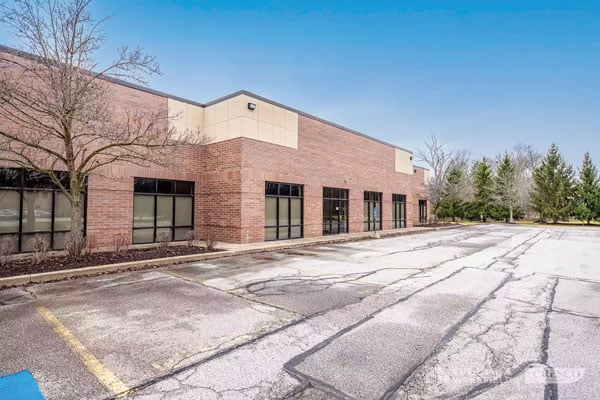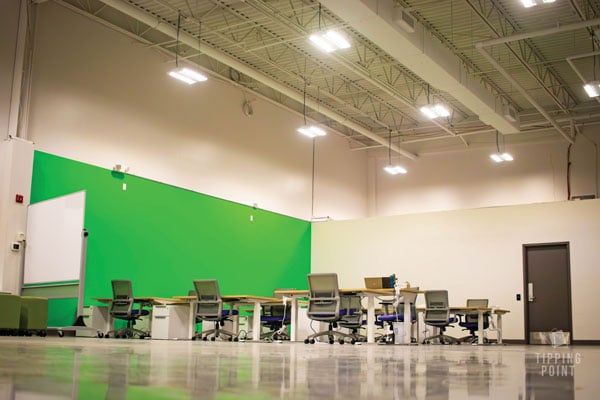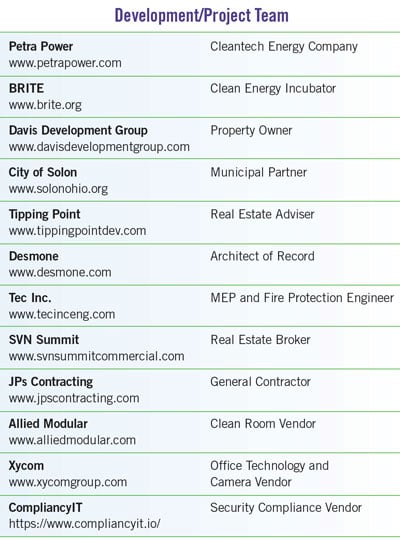
Advanced Manufacturing’s Rapid Growth: Finding the Right Real Estate
How one startup in northeast Ohio overcame the lack of move-in-ready space.
Companies are increasingly bringing manufacturing back to the United States, a trend accelerated by the supply chain disruptions experienced during the COVID pandemic. Consequently, the commercial real estate industry will need to make significant changes to accommodate the delivery of new product to support the reshoring movement.
Advanced manufacturing is likely to be one of the main catalysts of change. Both American and global enterprises are currently dedicating billions of dollars to the U.S. production of semiconductors, robotics, electric vehicle batteries, clean energy, and aerospace systems and components. This trend presents a significant opportunity for commercial real estate owners, investors and developers. A February 2024 NAIOP Research Foundation publication reported that construction is expected to expand the footprint of U.S. manufacturing space by 6% to 13% over the next decade.
Ramping Up for Rapid Growth
Enterprise-level advanced manufacturing companies are involved in new developments nationwide. One example is the new $20 billion Intel chip plant in Licking County, outside of Columbus, Ohio. It is the single-largest private-sector investment in Ohio’s history and is expected to provide 3,000 jobs at Intel’s new plant and an additional 7,000 construction jobs. The project broke ground in September 2022, and the first line of production is expected to come online at the end of 2025.
The state of Ohio, including its counties and cities, has prioritized advanced manufacturing as a key driver for its economic success. Over the past decade, many not-for-profit organizations have provided ecosystems for entrepreneurs to start, incubate, prototype, commercialize, scale and mature their innovative ideas.

The facility at 6565 Industrial Parkway in Solon, Ohio, featured the power requirements and loading docks that Petra Power required. Cushman & Wakefield/CRESCO Real Estate
While larger enterprises have calculated timelines to realize their own innovations through mega commercial real estate development projects, the same cannot be said for the rapidly growing community of startup companies that are ready to occupy commercial space. This is particularly true with hard tech companies in the clean energy sector. “Hard tech” refers to technology innovations that involve deep scientific research and often result in the creation of physical products of processes. Compared with software companies, hard tech often faces longer development cycles, higher capital requirements and more complex regulatory hurdles due to the physical nature of its products and the importance of reliability and safety in its applications.
“Startup companies that have proof-of-concept technologies, prototypes and products receive multimillion-dollar private investment and contract opportunities at a very fast pace. Once funding is acquired, investors and contract holders put a definitive timeline on the companies to prove the commercialization of their unique innovation,” explained Rick Stockburger, president of BRITE, Ohio’s only clean energy incubator.
BRITE serves startup companies across the state with direct mentorship, from the ideation phase to the commercialization of their products, including gaining access to capital. Located strategically in Cincinnati, Cleveland, Columbus and Warren, BRITE has served over 600 startups, secured more than $250 million in third-party investment to scale its member companies, and created more than 2,100 jobs across Ohio.
“Companies that reach the commercialization stage of their unique innovation have a difficult time navigating the existing commercial real estate landscape,” Stockburger continued. “The speed in which a company needs to scale their products versus the time that it takes to realize occupancy and start production could literally undo years’ worth of invention and proving a prototype. I believe these realities will cause a radical shift in how commercial real estate product is delivered in the future, as we had to leverage all our relationships throughout our robust ecosystem to help one of our own companies, Petra Power.”
Case Study: Petra Power
Petra Power is one of BRITE’s first portfolio companies to expand its operations outside of the incubator space in Warren. It is also one of the first startups born in northeast Ohio to commit its headquarters to the region instead of relocating to a different market. The company was founded in 2017 with the mission of helping to bridge the gap between fossil fuel and the clean energy economy of the future. Petra Power is developing a novel solid oxide fuel cell (SOFC) technology that will more efficiently create electricity from fossil fuels and lower entry barriers into hydrogen fuels for its customers.

The mission of Petra Power, a precision manufacturer of solid oxide fuel cells, is to bridge the world’s conversion from fossil fuels to clean fuels. BAM Advertising & Marketing
In 2018, Petra Power’s founders, Phillip Clift and Aaron Goodman, chose BRITE’s incubator in Warren, a city in the Mahoning Valley. It celebrated the ribbon-cutting of its new headquarters on Oct. 24, 2023, after officially signing a lease with a May 1 commencement date. The event marked a major milestone not only for the company but also for Ohio’s commitment to growing — and keeping — advanced manufacturing companies in the state. The area had been hard hit by the closures of several large steel operations between 1977 and 1984.
“Staying in northeast Ohio was an easy decision,” said Goodman, CEO of Petra Power. “Organizations like BRITE have created an environment where development and prototyping are feasible for hard tech companies, which is unique in our experience. The state of Ohio, as well as regional organizations, have invested a lot of time and money into providing resources for companies of all sizes that have helped Petra Power reach its current stage. On top of these clear benefits, Ohio is a particularly good place to develop a SOFC company, with a robust supply chain, advanced logistics, and a wide array of partner organizations that can help expedite development.”
With the help of BRITE’s ecosystem, the company landed a contract from an undisclosed federal agency in February 2023 to develop its SOFC technology. That meant finding an existing building that could accommodate Petra Power’s needs specific to its production process was critical to keeping the company in the region.
Critical Components: Time and Energy
Startup companies in the hard tech sector typically are driven by speed to market, yet also have exacting specifications for their buildings, which can take years to build out. Hard tech companies like Petra Power in the advanced manufacturing sector have distinct workflows and processes. This necessitates precision throughout the planning and construction processes. Furthermore, these companies have a demand for higher capacities of electrical utility service than were typically incorporated in the previous boom of tech/flex light industrial commercial real estate product over the past 20 years.

From left, Tipping Point President Jim Ambrose, Petra Power lab technician Jonah Rak, Petra Power founders Phillip Clift and Aaron Goodman, Solon Mayor Edward H. Kraus, Petra Power senior researcher Travis Peters, and BRITE President and CEO Rick Stockburger celebrate the opening of Petra Power’s new headquarters. BAM Advertising & Marketing
“Our contract provided us with an extremely limited time frame to find, design, build and occupy a space to scale the production of our product,” Goodman explained. “To achieve occupancy in such a short time, we understood that a new build was never going to be an option. We were going to have to find an existing light industrial space. However, we quickly learned that the existing commercial building stock lacked the power capacity that we needed to run our equipment. Unless current and future building owners invest in greater utility loads and capacities in their buildings, there could be a lot of difficulties for any region to make a transition from the older industrial economy to newer advanced manufacturing sectors.”
Increasing utility service and upgrading enclosures can make existing light industrial buildings suitable for occupancy. However, the time required to find a space and complete design, engineering, permitting, construction and inspection would have consumed a significant portion of Petra Power’s contract period.
Petra Power and its broker, SVN Summit Commercial Real Estate Advisors, researched more than 100 properties and toured dozens of them across several counties in northeast Ohio. Only a few locations met the minimum power, loading dock and warehouse space requirements that would support Petra Power’s manufacturing process.
“We leveraged every relationship that we could throughout the brokerage community to find the exact property that met the unique needs of Petra Power,” said Aaron Davis, senior adviser at SVN Summit. “Ample power was usually the culprit for not making a deal work, but in rare situations where we had the power, the landlord or owner wasn’t properly maintaining the enclosure of their building to provide the thermal consistency needed for a clean room and other testing equipment to operate efficiently.”
Finding the Right Fit
In conjunction with SVN Summit, Petra Power’s next step in expanding its search was using BRITE’s connections with nonprofit economic development entities whose missions involve attracting and retaining job creators in the northeast Ohio market. One of those nonprofits, Team NEO (an acronym for North East Ohio), helped the team connect directly to local municipalities and property owners who support the advancement of Ohio’s overall strategy of job creation in Industry 4.0.

Approximately 9,000 square feet of existing office space was demolished to provide Petra Power with more open warehouse space and the flexibility to convert into laboratory space. BAM Advertising & Marketing
One property that stood out was 6565 Industrial Parkway in Solon, located about 20 miles east of downtown Cleveland. The original 13,500-square-foot facility featured abundant office space from the 1990s, ample power requirements and convenient loading docks for Petra Power’s needs. The property owner, Davis Development Group, was willing to work with Petra Power’s aggressive timeline. It demolished the existing office space (approximately 9,000 square feet) to provide more open warehouse space, which offered Petra the flexibility to convert into laboratory space. The ownership team was also eager to collaborate with Petra Power’s design and engineering team to understand how their equipment and utility loads could efficiently connect to the building’s existing infrastructure.
“The ecosystem is what makes all this work in Ohio,” Stockburger said. “We were fortunate to find a building that was right for Petra Power. As we look into the future, it’s about investing in infrastructure and being able to have shovel-ready sites — not just for the megasites, but for the supply chain sites where startups can grow out of an incubator like ours and find a landing spot to get to that next step.”
Working With the City to Ensure Timeliness
Petra Power wanted to work with a municipality that valued the high-quality jobs and economic benefit that its relocation would provide (20 new jobs with a projected value of $2.2 million in payroll).
When Petra Power was connected to Angee Shaker, director of economic development for the city of Solon, she saw a big opportunity.
“Attracting a company like Petra Power is ideal for Solon,” Shaker said. “This is an innovative, cutting-edge, environmentally friendly company that is going to bring with it great jobs. This is the type of company we want to see here.”
Petra Power believed that including the municipality’s building, engineering, planning and safety departments upfront to inform the design and engineering process would minimize surprises and delays throughout the permitting, inspection and occupancy processes.
Shaker and all of Solon’s participating departments were helpful and efficient, providing guidance to ensure that not only would the space be suitable for Petra Power but would also meet municipal code standards to be ready for inspections and occupancy.
“Business tends to attract business,” Shaker said. “When other innovative companies see the great space that Petra Power has created, along with the amenities that the city of Solon has to offer, and how efficiently our city team functions, we anticipate Petra Power’s journey will attract more of these types of business to northeast Ohio.”
Hypothetical Planning Pays Off
Traditionally, most companies that want to establish a headquarters decide to wait until they have a signed lease before design and engineering teams begin production on a set of permit and construction drawings to achieve occupancy. The time and effort required to translate Petra Power’s unique manufacturing process into a set of architecture and engineering standards was a large endeavor by itself.
Petra Power decided to approach this daunting process in a unique way. Instead of waiting to find a property, the company opted to start coordinating design and engineering to integrate all of its operational requirements into a “hypothetical space” plan, which then served as the guiding principles of integrating its operation into an existing space once a lease was signed. While the broker team conducted its own property search, the Desmone and Tec Inc. architecture and engineering teams integrated themselves with Petra Power’s internal engineering team to solve as many hypotheticals of clean room and equipment layouts as possible.
“It was really productive to spend the time upfront with Petra Power’s engineering team and match their requirements to the standards that the mechanical, electrical and plumbing (MEP) engineers would need to integrate into whatever building we ultimately ended up with. With our expertise, the team quickly determined which spaces would most efficiently achieve occupancy,” said Brian Gruendl, lead architect for Desmone.

“Working in conjunction with the architect during the site selection phase had a big impact on helping us speed up the design,” said Steve Bohn, electrical engineer and project manager for Tec Incorporated Engineering & Design.
Bohn continued, “As MEP engineers, we’re kind of looked at as a necessary evil. The typical duration for a project of this complexity would be two years, with engineering taking up to six months. Since we could get into the design early and incorporate MEP standards into whichever building Petra selected, it really streamlined the process.”
The various project stakeholders appreciated the upfront collaboration. By bringing the general contractor into the pre-design process, the team was able to understand the realistic lead times for crucial components of the space. Although lead times were an issue with certain pieces of electrical equipment, the architecture, engineering and construction teams were able to plan for code-compliant temporary solutions that would allow Petra Power to launch, with the understanding that once the equipment for long-term success arrived onsite, crews would return to swap it out.
“Being involved with the development team at the beginning was great,” said Jeffrey Peifer, vice president of JPs Contracting. “We don’t typically get to experience this level of organization and coordination before a construction drawing set is completed. We spent a couple of long days going to space after space throughout northeast Ohio to weigh the pros and cons of how to best integrate Petra Power’s process into the existing building. We were together since day one.”
In the end, Petra Power was able to achieve occupancy in six months from signing a lease, possible only because of the three months spent investigating various hypothetical situations before finding a space. Startup companies like Petra Power can quickly and decisively move forward on their projects if all of the professionals involved provide ample amounts of information for decision-making.
As of March 2024, roughly six months after occupancy, Petra Power was already delivering on its economic impact promises. It has added eight full-time jobs and more than $500,000 worth of payroll, with hopes of doubling the employee headcount in the coming months.
The Need for Speed
Petra Power is one of several hundred startup companies in the advanced manufacturing sector that are rapidly emerging throughout the United States. The speed with which the entrepreneurs behind these innovations ideate, plan and act on the implementation of their products will create growing pressure on how commercial space is delivered. Petra Power’s journey through the commercial real estate process indicates that traditional delivery timelines to occupy commercial space can be accelerated.
When advanced manufacturing companies, municipalities, property owners and project execution professionals collaborate from the outset of the planning process, transformative change within the commercial real estate industry is not just possible but inevitable.
Jim Ambrose is the president of Tipping Point, which served as Petra Power’s real estate adviser.




